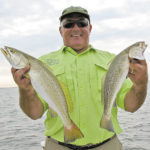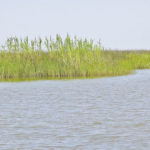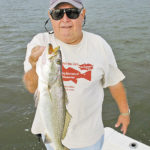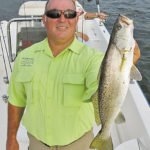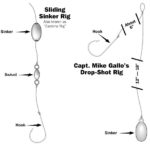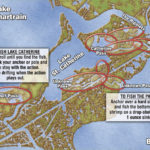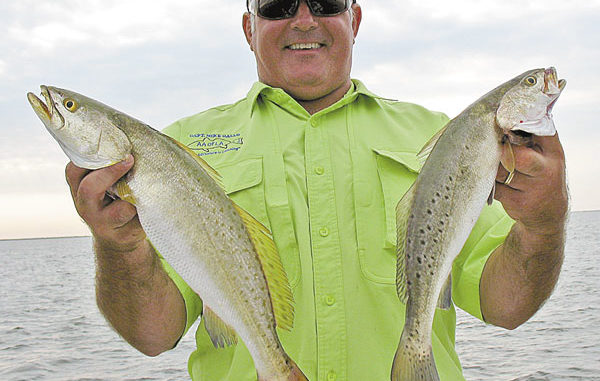
Fishing the eastern Lake Pontchartrain area has similarities with football this time of year.
Fall is falling, and that means football season is under way. Fans are excited about the prospects of a good season as they pull for their favorite teams at the high school, college and professional levels.
Fall also begins the season for other games as well, as hunting season cranks up and anglers find themselves motivated to get back on the water in pursuit of a great variety of finned species. The sweltering summer heat is over for another year, the effects of the oil spill fiasco are subsiding and folks are feeling good about Louisiana seafood again.
And with fall, a little light automatically goes off in the thoughts of every coastal angler, a reminder that there is no better time of the year to be on the water. That’s especially true this month as cold fronts actually make their way south and winds from the northwest begin the annual flushing of the marsh. Shrimp are caught up in the flow of water, and make their inevitable trek through the passes this month.
Hungry trout are licking their chops in anticipation.
I asked Capt. Mike Gallo (985-781-7811) to squeeze me in on a trip in the Rigolets area, and he and his uncle by marriage, Dan Couvillion, obliged by letting me join them on a recent trout hunt. I woke up to blustery winds out of the northwest and the threat of thunderstorms, and really thought about going back to bed. Surely Capt. Mike would cancel this trip, or so I figured.
But a quick phone conversation assured me he had every intention of going out on the water that morning, and though the original game plan might have to be altered to fit the conditions, our trip was still very much “on.”
We pulled away from his camp just as the sun was trying to break through overcast skies. Actually, the sun never did break through that morning, and we fished under what is usually late fall and early winter conditions. It was a chilly boat ride to our destination, and I was totally unprepared for it. It’s been a long, long, hot summer, and I was outfitted in typical summer fashion. I actually tried to remember the last time I was chilly on a boat ride.
Our original plan was to fish Lake Catherine, which usually really turns on in October, but the shallow nature of the lake (average depth ranges from 4 to 6 feet) makes it susceptible to stiff winds.
Gallo had a Plan B in mind, and took us down Rigolets Pass.
Our first stop was behind the bridge in Rigolets Pass (on the east side, beside Fort Pike) where Gallo anchored the 23-foot bay boat. His favorite technique in that deeper water is to fish a drop-shot rig, using a 1-ounce sinker and a live shrimp. He prefers the drop-shot rig over a sliding-sinker rig because the shrimp can’t really burrow into the bottom as easily on the drop-shot rig.
Long experience has taught me to go with what the captain is using for the best chance of success. I have my own favorite rigs and baits and colors and techniques, but these captains are experts at fishing their particular areas, and through the years they have tested and honed their methods and baits to a fine edge. My point: See what the captain is using and how he fishes it, and do the same thing.
I tied the drop-shot rig onto the end of my line, loaded the hook with a healthy live shrimp and tossed it into the deep water.
The water behind the bridge ranges from 30 to 40 feet deep, but Gallo looked for a rise on the bottom using his depth sounder. He found what he was looking for — a section where the depth came up to 24 feet, and that’s where he dropped anchor. I assumed the object was to fish along the ledge, so that’s where I tried to cast my bait.
“We’re going to give this spot 30 minutes,” Gallo announced. “If it doesn’t produce by then, we’ll move on.”
“Aye aye, captain,” we saluted in mock reply.
“This pass can produce some very nice fish this time of year,” Gallo said. “Four- and 5-pound trout are not really that unusual, and trout up to 6, 7 and even 8 pounds have come out from right here, and in fact, the No. 3 trout ever caught in the state of Louisiana, a monster speckled trout tipping the scales at over 11 pounds, was caught right here, so we want to give it a chance to produce.”
So we gave it a chance, and it produced. The trout were slow to start up, but once they did, they hit our live shrimp with some authority. The key was to toss upcurrent and allow the bait to sink all the way to the bottom. Once it did, and the current moved it down a bit into the strike zone, you’d catch a trout. Or, you’d catch a catfish. And we caught plenty of both.
I seemed to have the catfish anointing for awhile there, catching both sailcats and hardheads in all sizes. But then we’d hook into some 2-pound specks also.
Gallo did hook one very nice trout there that might have gone 3 to 4 pounds, but the slow response of the net-man (that was Dan) and the unwise decision of the captain to lift a lip-hooked whopper over the side of the boat resulted in its escape. I razzed Gallo and Dan about it the rest of the morning, making me lose such a great photo opportunity.
Gallo did comment in admiration of my new reel, one of the new Shimano Curados.
“High-speed retrieve, low profile, light in the hand,” I said, stating its merits.
“Does Curado mean ‘catfish’ in Spanish?” he asked. “Because it sure is a great catfish reel.”
“No, it doesn’t mean catfish,” I answered.
“Well, are you sure? What does it mean then?” he queried.
“I don’t know what it means,” I answered, as I reeled in another hardhead. But I figured I’d better look it up in a Spanish dictionary when I got home.
When the action played out and we were convinced it was time to move, Gallo pulled up the anchor and headed us down Blind Rigolets, also known as Little Rigolets Pass, and anchored the boat within sight of the bridge over the pass, nearly to the ICW.
“The passes will really begin to turn on this month,” Gallo said, as the boat settled its motion and we reloaded our drop-shot rigs with live shrimp. “The fronts blow through, the shrimp move out of the lake with the current and the trout are all over these passes, looking for an easy meal.
“I like to anchor at a spot where there is a good shell bottom, and the way you determine that is to look for brush growing along the pass and roseau cane. If the roseau cane is standing up in a section of marsh, fish along the water there. I’ve found the cane likes a hard bottom.”
His theory is that the trout prefer to hunt over a hard bottom because the shrimp can’t as easily escape as they could over a soft bottom, where in a split-second they can disappear into the mud to evade predators. Most predators are lazy by nature, and will always choose the easy way to feed over the hard way.
Whether or not you agree with the theory, it makes sense, and better than that, it works. We anchored along the roseau cane, and fished the bottom just like before. Once again, the fish seemed reluctant to bite, but once they started up, they hit consistently. The live shrimp were just too much temptation.
Gallo says all of the main passes will be productive this month.
“Think of the passes as highways, and the shrimp will have to travel through those passes as they move out of the lake, especially during those northwest winds,” he said. “Pass Rigolets, Chef Pass, Blind Rigolets, Unknown Pass, Counterfeit Pass, Millers Ditch and Pearl River are all good choices right now.
“Look for roseau cane, and if you’re not sure if the bottom is shells, drop a 1-ounce sinker down on the end of your line and get a feel of the bottom. If you find shells, fish there. If not, move until you do find a hard bottom.”
Gallo says you may have to do a lot of “stick-and-move” before you bump into the fish.
“That’s just the way it is right now,” he said. “The fish are scattered, this is a transition month and you’ll probably have to do some hunting. Give a spot a chance to produce, but if it doesn’t, don’t homestead. Move!
“But the good thing is, once you do locate them, you can keep coming back, day after day, to the very same spot, and still catch fish. You won’t deplete them because they’ll move in and restock those same spots overnight, like the stock boys do at Wal-Mart.”
We sat there and caught quite a few trout, many of them in the 2-pound-and-over range.
I do admit that I also caught quite a number of catfish. And just to make sure, I dug out my Spanish dictionary when I got home, and curado is not in it. So, curado does not, I repeat, does not, mean catfish.
The closest Spanish word I could find to curado, was cunado, which means brother-in-law.
I don’t know which is worse.
Capt. Mike Gallo can be reached at (985) 781-7811.
